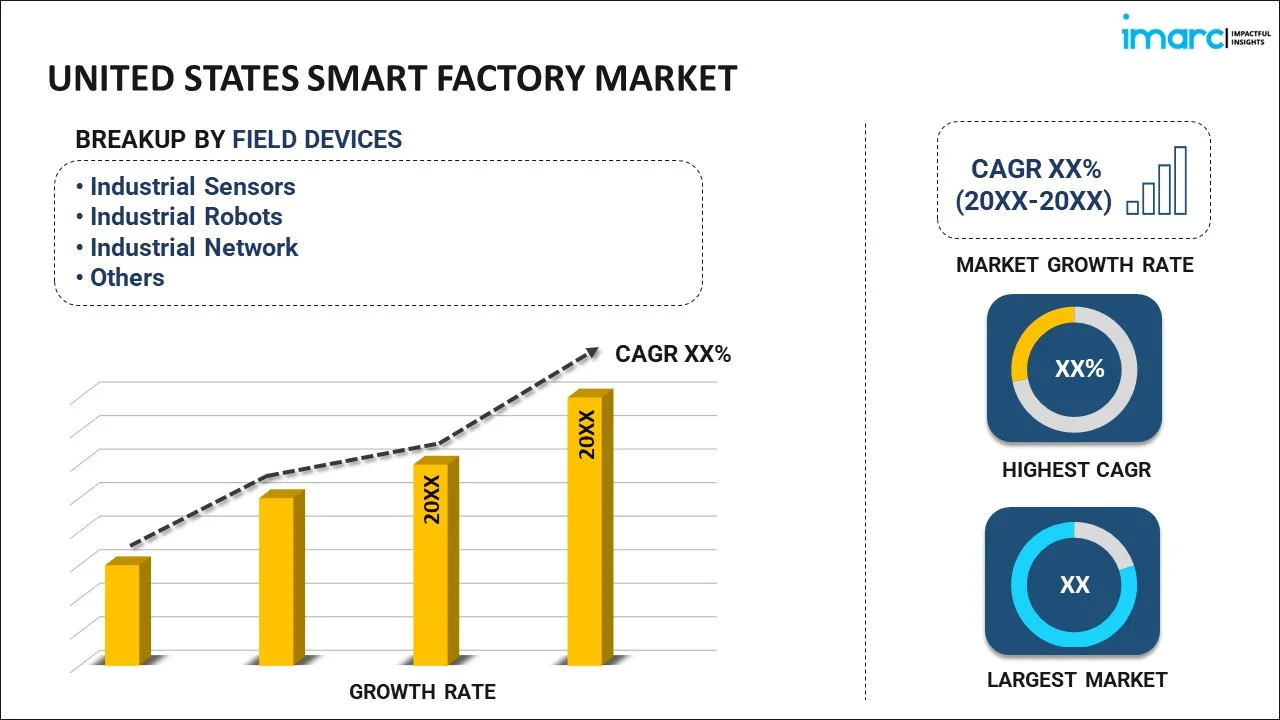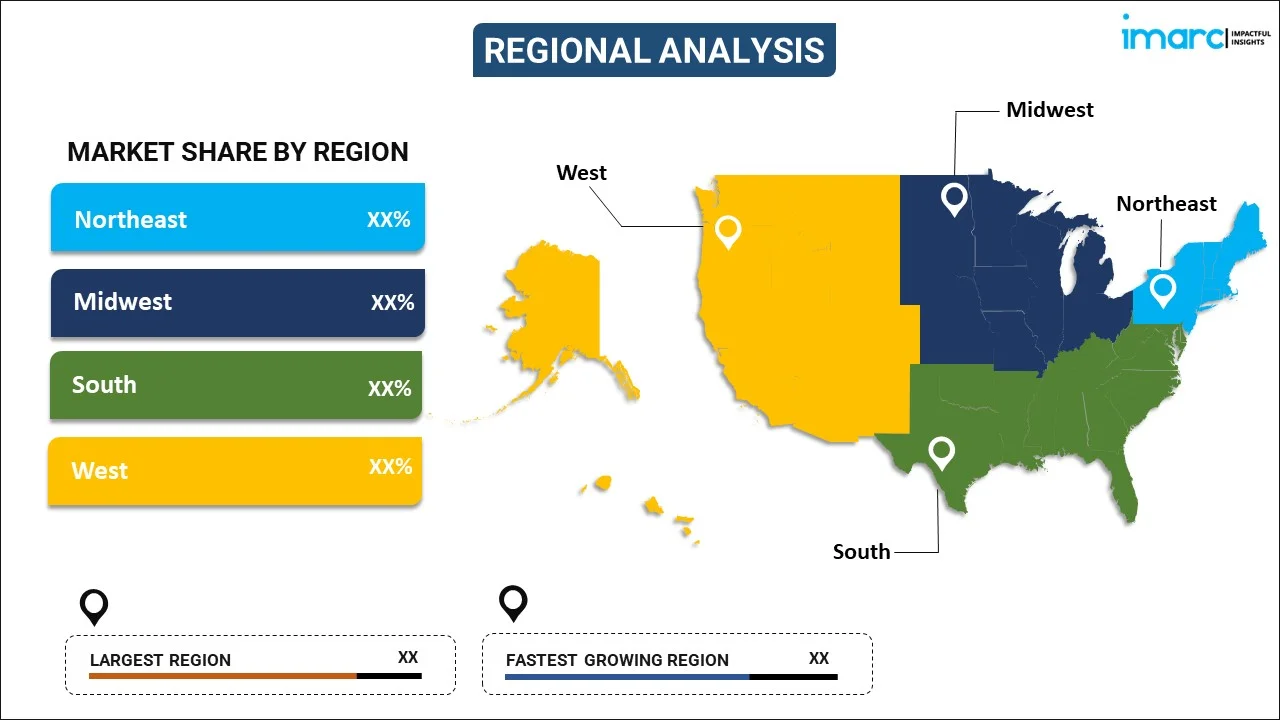
United States Smart Factory Market Report by Field Devices (Industrial Sensors, Industrial Robots, Industrial Network, Industrial 3D Printers, Machine Vision Systems), Technology (Product Lifecycle Management (PLM), Human Machine Interface (HMI), Enterprise Resource Planning (ERP), Manufacturing Execution Systems (MES), Distributed Control Systems (DCS), Industrial Control System, and Others), End Use Industry (Pharmaceuticals, Food and Beverages, Chemical, Oil and Gas, Automotive and Transportation, Semiconductor and Electronics, Aerospace and Defense, and Others), and Region 2024-2032
Market Overview:
United States smart factory market size is projected to exhibit a growth rate (CAGR) of 12.10% during 2024-2032. The growing demand for automated manufacturing processes to reduce labor costs and enhance precision, consistency, and speed, rising adoption of industry 4.0 principles, and increasing emphasis on workforce training and upskilling programs represent some of the key factors driving the market.
|
Report Attribute
|
Key Statistics
|
|---|---|
|
Base Year
|
2023 |
|
Forecast Years
|
2024-2032
|
|
Historical Years
|
2018-2023
|
| Market Growth Rate (2024-2032) | 12.10% |
A smart factory, also known as an intelligent factory or digital factory, is a manufacturing facility that utilizes advanced technologies, such as the internet of things (IoT), artificial intelligence (AI), robotics, and data analytics, to optimize its operations and production processes. It encompasses several key aspects, including automation, connectivity, and data-driven decision-making. It is manufactured by the employment of sensors and connected devices throughout the production floor, which enables collection of real-time data on various aspects of the manufacturing process. It can quickly adapt to changes in production requirements, allowing for greater flexibility in manufacturing. It reduces waste and energy consumption, contributing to a more sustainable manufacturing industry. It can quickly adapt to market changes, enabling a more agile response. It finds application across various industries, including automotive, electronics, pharmaceuticals, and consumer goods.
United States Smart Factory Market Trends:
At present, the increasing adoption of industry 4.0 principles, characterized by the integration of digital technologies, such as IoT, AI, and data analytics, into manufacturing processes represents one of the key factors impelling the market growth in the United States. This transformation is also enabling the creation of highly efficient and connected smart factories. Moreover, the growing demand for automated manufacturing processes to reduce labor costs and enhance precision, consistency, and speed is offering a favorable market outlook. Besides this, the rising integration of IoT devices and sensors into machinery and equipment, creating a network of interconnected devices, is bolstering the market growth in the country. The enhancements in connectivity also enable seamless communication between machines, systems, and even supply chain partners, facilitating real-time monitoring and control. In addition, the increasing cybersecurity and data privacy concerns as smart factories are becoming more reliant on interconnected systems and data sharing are resulting in the implementation of robust cybersecurity measures to protect sensitive manufacturing data from cyber threats and unauthorized access. Apart from this, the growing sustainability concerns are encouraging smart factories to reduce waste, optimize resource usage, and minimize their environmental footprint. These efforts align with corporate sustainability goals (CSG) and regulatory requirements, making smart factory technologies an attractive choice for companies looking to improve their environmental impact. Additionally, the rising emphasis on workforce training and upskilling programs, as smart factories require a workforce with digital skills and expertise in handling advanced technologies is supporting the market growth in the country. Furthermore, the increasing prevalence of digital twins, which are virtual replicas of physical manufacturing systems for enhancing decision-making and reducing the risk of costly errors are contributing to the market growth. These digital twins also enable real-time monitoring and simulations, allowing manufacturers to test and optimize processes before implementing changes on the factory floor.
United States Smart Factory Market Segmentation:
IMARC Group provides an analysis of the key trends in each segment of the market, along with forecasts at the country level for 2024-2032. Our report has categorized the market based on field devices, technology, and end use industry.
Field Devices Insights:

- Industrial Sensors
- Industrial Robots
- Industrial Network
- Industrial 3D Printers
- Machine Vision Systems
The report has provided a detailed breakup and analysis of the market based on the field devices. This includes industrial sensors, industrial robots, industrial network, industrial 3D printers, and machine vision systems.
Technology Insights:
- Product Lifecycle Management (PLM)
- Human Machine Interface (HMI)
- Enterprise Resource Planning (ERP)
- Manufacturing Execution Systems (MES)
- Distributed Control Systems (DCS)
- Industrial Control System
- Others
A detailed breakup and analysis of the market based on the technology have also been provided in the report. This includes product lifecycle management (PLM), human machine interface (HMI), enterprise resource planning (ERP), manufacturing execution systems (MES), distributed control systems (DCS), industrial control system, and others.
End Use Industry Insights:
- Pharmaceuticals
- Food and Beverages
- Chemical
- Oil and Gas
- Automotive and Transportation
- Semiconductor and Electronics
- Aerospace and Defense
- Others
The report has provided a detailed breakup and analysis of the market based on the end use industry. This includes pharmaceuticals, food and beverages, chemical, oil and gas, automotive and transportation, semiconductor and electronics, aerospace and defense, and others.
Regional Insights:

- Northeast
- Midwest
- South
- West
The report has also provided a comprehensive analysis of all the major regional markets, which include the Northeast, Midwest, South, and West.
Competitive Landscape:
The market research report has also provided a comprehensive analysis of the competitive landscape. Competitive analysis such as market structure, key player positioning, top winning strategies, competitive dashboard, and company evaluation quadrant has been covered in the report. Also, detailed profiles of all major companies have been provided.
United States Smart Factory Market Report Coverage:
| Report Features | Details |
|---|---|
| Base Year of the Analysis | 2023 |
| Historical Period | 2018-2023 |
| Forecast Period | 2024-2032 |
| Units | US$ Million |
| Scope of the Report | Exploration of Historical and Forecast Trends, Industry Catalysts and Challenges, Segment-Wise Historical and Predictive Market Assessment:
|
| Field Devices Covered | Industrial Sensors, Industrial Robots, Industrial Network, Industrial 3D Printers, Machine Vision Systems |
| Technologies Covered | Product Lifecycle Management (PLM), Human Machine Interface (HMI), Enterprise Resource Planning (ERP), Manufacturing Execution Systems (MES), Distributed Control Systems (DCS), Industrial Control System, Others |
| End Use Industries Covered | Pharmaceuticals, Food and Beverages, Chemical, Oil and Gas, Automotive and Transportation, Semiconductor and Electronics, Aerospace and Defense, Others |
| Regions Covered | Northeast, Midwest, South, West |
| Customization Scope | 10% Free Customization |
| Report Price and Purchase Option | Single User License: US$ 3699 Five User License: US$ 4699 Corporate License: US$ 5699 |
| Post-Sale Analyst Support | 10-12 Weeks |
| Delivery Format | PDF and Excel through Email (We can also provide the editable version of the report in PPT/Word format on special request) |
Key Questions Answered in This Report:
- How has the United States smart factory market performed so far and how will it perform in the coming years?
- What has been the impact of COVID-19 on the United States smart factory market?
- What is the breakup of the United States smart factory market on the basis of field devices?
- What is the breakup of the United States smart factory market on the basis of technology?
- What is the breakup of the United States smart factory market on the basis of end use industry?
- What are the various stages in the value chain of the United States smart factory market?
- What are the key driving factors and challenges in the United States smart factory?
- What is the structure of the United States smart factory market and who are the key players?
- What is the degree of competition in the United States smart factory market?
Key Benefits for Stakeholders:
- IMARC’s industry report offers a comprehensive quantitative analysis of various market segments, historical and current market trends, market forecasts, and dynamics of the United States smart factory market from 2018-2032.
- The research report provides the latest information on the market drivers, challenges, and opportunities in the United States smart factory market.
- Porter's five forces analysis assist stakeholders in assessing the impact of new entrants, competitive rivalry, supplier power, buyer power, and the threat of substitution. It helps stakeholders to analyze the level of competition within the United States smart factory industry and its attractiveness.
- Competitive landscape allows stakeholders to understand their competitive environment and provides an insight into the current positions of key players in the market.
Need more help?
- Speak to our experienced analysts for insights on the current market scenarios.
- Include additional segments and countries to customize the report as per your requirement.
- Gain an unparalleled competitive advantage in your domain by understanding how to utilize the report and positively impacting your operations and revenue.
- For further assistance, please connect with our analysts.
 Inquire Before Buying
Inquire Before Buying
 Speak to an Analyst
Speak to an Analyst
 Request Brochure
Request Brochure
 Request Customization
Request Customization




.webp)




.webp)












